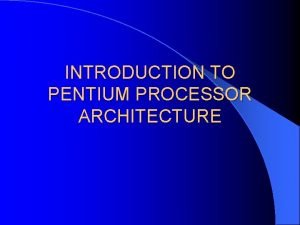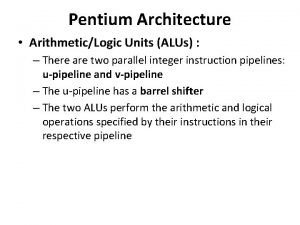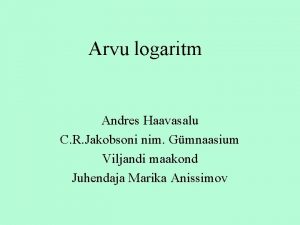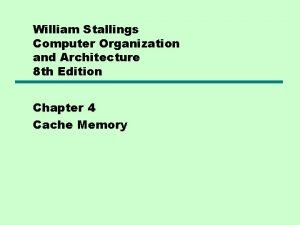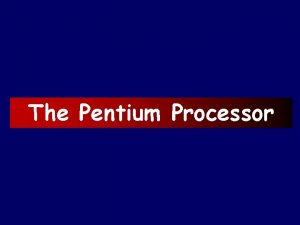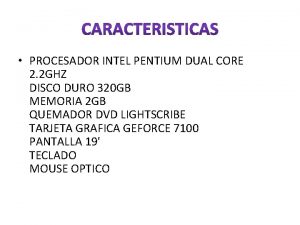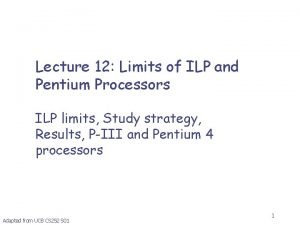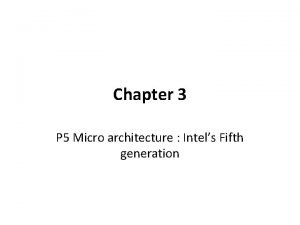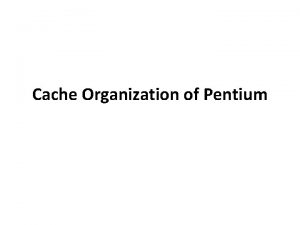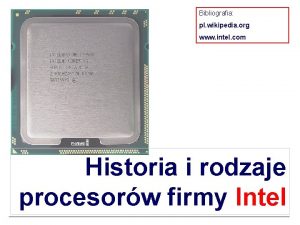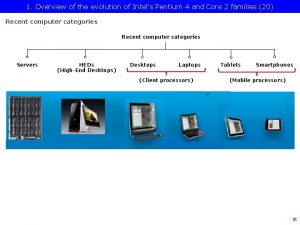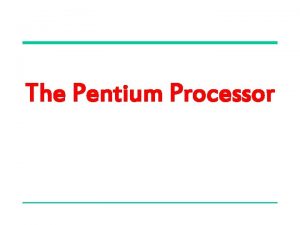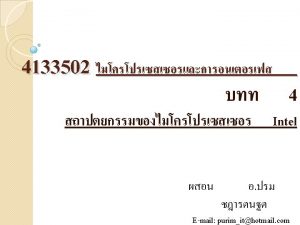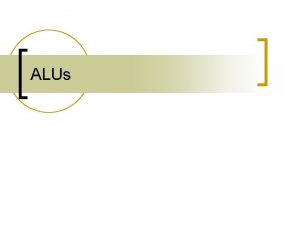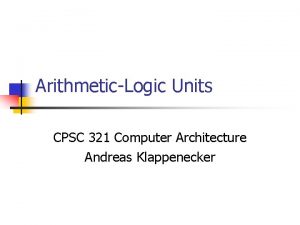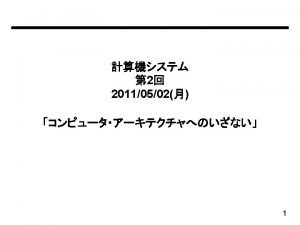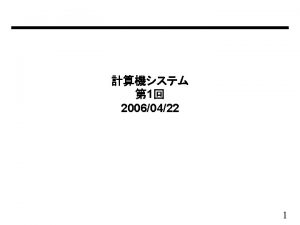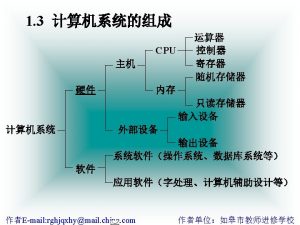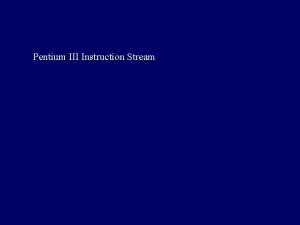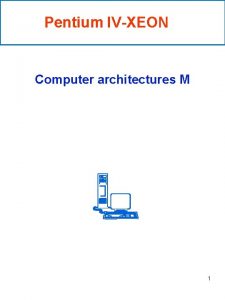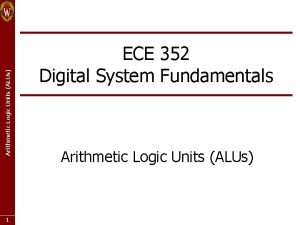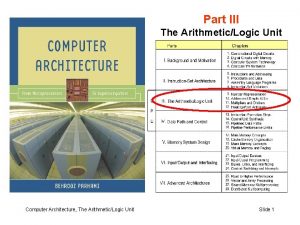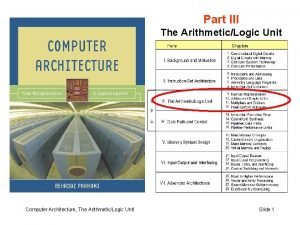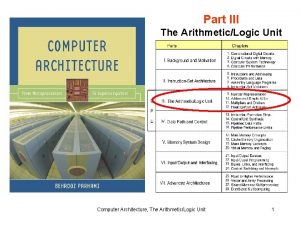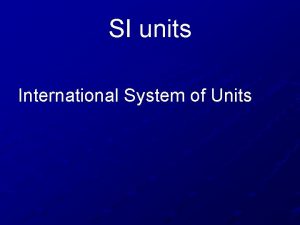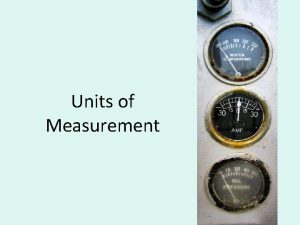Pentium Architecture ArithmeticLogic Units ALUs There are two




















- Slides: 20

Pentium Architecture • Arithmetic/Logic Units (ALUs) : – There are two parallel integer instruction pipelines: u-pipeline and v-pipeline – The u-pipeline has a barrel shifter – The two ALUs perform the arithmetic and logical operations specified by their instructions in their respective pipeline


Pentium Architecture • Address Generators : – Two address generators (one for each pipeline) form the address specified by the instructions in their respective pipeline. – They are equivalent to segmentation unit. • Paging Unit : – If enabled, it translates linear address (from address generator) to physical address – It can handle two linear addresses at the same time to support both pipelines with one TLB per cache


Pentium Architecture • Floating Point Unit: – It can accept upto two floating point operations per clock when one of the instruction is an exchange instruction – Three types of floating point operations can operate simultaneously within FPU: addition, division and multiplication.


Pentium Architecture • Data Cache: – It is an 8 KB write-back two way set associative cache with line size of 32 bytes


Pentium Architecture • Bus Unit: • Address Drivers and Receivers: – Push address onto the processor’s local address bus (A 31: A 3 and BE 7: BE 0 ) • Data Bus Transceivers: – gate data into the processor ‘s local data bus • Bus Control Logic: – controls whether a standard or burst bus cycle is to be run


Pentium Architecture • Branch Target Buffer: supplies jump target prefetch addresses to the code cache


Superscalar Operation • The prefetcher sends an address to code cache and if present, a line of 32 bytes is send to one of the prefetch buffers • The prefetch buffer transfers instructions to decode unit • Initially it checks if the instructions can be paired.

Superscalar Operation • If paired, one goes to ‘u’ and other goes to ‘v’ pipeline as long as no dependencies exist between them. • Pair of instructions enter and exit each stage of pipeline in unison

Superscalar Operation • Pentium uses a five stage execution pipeline as shown:

Integer Pipeline UQ: Explain in brief integer instruction pipeline stages of Pentium

Integer Pipeline • The pipelines are called “u” and “v” pipes. • The u-pipe can execute any instruction, while the v-pipe can execute “simple” instructions as defined in the “Instruction Pairing Rules”. • When instructions are paired, the instruction issued to the v-pipe is always the next sequential instruction after the one issued to u-pipe.

Integer Pipeline • The integer pipeline stages are as follows: 1. Prefetch(PF) : – Instructions are prefetched from the on-chip instruction cache 2. Decode 1(D 1): – Two parallel decoders attempt to decode and issue the next two sequential instructions – It decodes the instruction to generate a control word

Integer Pipeline – A single control word causes direct execution of an instruction – Complex instructions require microcoded control sequencing 3. Decode 2(D 2): – Decodes the control word – Address of memory resident operands are calculated

Integer Pipeline 4. Execute (EX): – The instruction is executed in ALU – Data cache is accessed at this stage – For both ALU and data cache access requires more than one clock. 5. Writeback(WB): – The CPU stores the result and updates the flags
 Insidan region jh
Insidan region jh Intel pentium processor architecture
Intel pentium processor architecture Pentium architecture
Pentium architecture Lauseliikmed
Lauseliikmed Rombi pindala arvutamine
Rombi pindala arvutamine Potentseerimine
Potentseerimine Kampus wong alus
Kampus wong alus Pangertosan
Pangertosan Bahasa krama alus njaluk
Bahasa krama alus njaluk Bocouture doses
Bocouture doses When units manufactured exceed units sold:
When units manufactured exceed units sold: Pentium 4 cache organization
Pentium 4 cache organization Pentium history
Pentium history Ghz
Ghz Ilp
Ilp Comparison of 8086 and 80386
Comparison of 8086 and 80386 Instruction issue algorithm of pentium processor
Instruction issue algorithm of pentium processor Explain cache organization of pentium
Explain cache organization of pentium Intel pentium 4 wiki
Intel pentium 4 wiki Pentium evolution
Pentium evolution Pentium 1 2 3 4
Pentium 1 2 3 4

